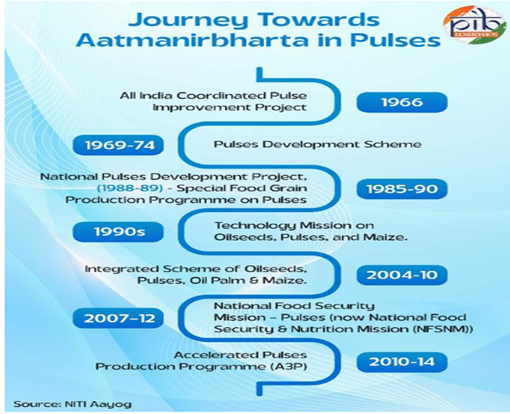Introduction:
India’s pulses sector stands at the crossroads of nutritional security, self-reliance, and farmer welfare. As the largest global producer and consumer of pulses, India still relies on imports to meet domestic demand.
Recognising this challenge, Prime Minister Narendra Modi launched the “Mission for Aatmanirbharta in Pulses” on October 11, 2025, at IARI, New Delhi. With an outlay of ₹11,440 crore, the Mission aims to make India fully self-sufficient in pulses by December 2027, integrating productivity enhancement, assured procurement, and value-chain development.
Background

Objective
The Mission for Aatmanirbharta in Pulses (2025–31) aims to:
-
- Achieve self-sufficiency in pulses and reduce import dependence.
- Expand cultivation by 35 lakh hectares, especially in rice fallows and suitable areas.
- Promote intercropping, diversification, and climate-resilient practices.
- Develop and distribute 126 lakh quintals of certified seeds and 88 lakh free seed kits.
- Enhance farmers’ income through assured procurement, technology adoption, and value-chain development.
Key Takeaways
-
- Mission Period: 2025–26 to 2030–31
- Budgetary Outlay: ₹11,440 crore
- Target: 350 lakh tonnes production; 310 lakh hectares area under pulses by 2030–31
- Seed Support: 88 lakh free seed kits and 126 lakh quintals certified seeds to be distributed
- Beneficiaries: Nearly 2 crore farmers
- Procurement: 100% MSP procurement of Tur (Arhar), Urad, and Masoor for four years under PM-AASHA
- Value Chain: 1,000 processing & packaging units with subsidy up to ₹25 lakh per unit
- Focus: Climate-resilient varieties, crop diversification, and sustainable soil health
India’s Pulse Production – The Context
-
- Production grew from 192.6 lakh tonnes (2013–14) to 252.38 lakh tonnes (2024–25) — a 31% increase under NFSM-Pulses.
- Imports still at 47.38 lakh tonnes (2023–24) highlight the need for domestic capacity expansion.
- The Mission builds upon initiatives like A3P (Accelerated Pulses Production Programme) and the National Food Security Mission.
- The initiative aligns with Vision 2047 — aiming at sustainable growth, nutritional adequacy, and farmer prosperity.
Operational Strategy
-
- Seed Ecosystem:
- States to prepare five-year seed production plans.
- ICAR to monitor breeder seed supply and quality control through SATHI (Seed Authentication, Traceability & Holistic Inventory) portal.
- Promotes “One Block–One Seed Village” for local seed hubs and FPO-led distribution.
- Production Enhancement:
- Expansion of 35 lakh ha in rice fallows and suitable lands.
- Focus on high-yielding, pest-resistant, and short-duration varieties.
- Emphasis on intercropping and balanced fertilizer use for soil health improvement.
- Procurement Assurance (PM-AASHA):
- NAFED and NCCF to ensure complete MSP procurement for key pulses for 4 years.
- Guarantees fair prices, reduced market volatility, and income stability for farmers.
- Value Chain Strengthening:
- Establishment of 1,000 processing & packaging units to reduce post-harvest losses.
- Promotes cluster-based model recommended by NITI Aayog to enhance resource efficiency.
- Seed Ecosystem:
Technological and Institutional Support
-
- SATHI Portal: Tracks the entire seed lifecycle from production to retail, ensuring transparency and traceability.
- ICAR & KVKs: To conduct field demonstrations, promote mechanization, and disseminate best practices.
- NITI Aayog’s Recommendations:
- Integrate pulses into PDS and Mid-Day Meal schemes for nutritional outreach.
- Strengthen seed hubs, FPOs, and local procurement centers.
- Encourage bio-fertilizers, efficient irrigation, and AI-based early warning systems for pest/disease monitoring.
Expected Outcomes (By 2030–31)
| Parameter | Target |
|---|---|
| Area under pulses | 310 lakh ha |
| Production | 350 lakh tonnes |
| Yield | 1,130 kg/ha |
| Processing Units | 1,000 |
| Farmers Benefited | ~2 crore |
| Import Reduction | Complete self-sufficiency by 2027 |
Significance
-
- Advances Aatmanirbhar Bharat and Viksit Bharat 2047 goals.
- Strengthens food and nutritional security by increasing protein availability.
- Enhance farm incomes, employment, and foreign exchange savings.
- Encourages climate-smart agriculture and sustainable cropping systems.
- Supports rural industrialization through agri-value chain integration.
Conclusion:
By coupling scientific innovation with assured procurement and value-chain linkages, it envisions a resilient pulses ecosystem that boosts farmer incomes, soil health, and national self-sufficiency.
Spread the Word
